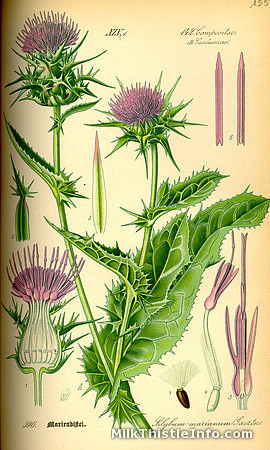

According to legend, when Holy Mary was fleeing from King Herod with the baby Jesus, during one stop while she was feeding her child, a drop of milk fell on a thistle growing nearby, and stained its leaves. The inconspicuous thistle felt greatly honoured and wanted to keep a trace of Virgin Mary’s milk on its leaves. Since that day, the leaves of milk thistle have a white pattern of veins. The legend is reflected in the Latin name of the species: marianum and in the German name: Mariendistel (thistle of Virgin Mary).2, 3 Milk thistle was traditionally given to breastfeeding women, to increase lactation.
Milk thistle is an annual plant. At first it forms a rich rosette of green leaves, with white veins. The leaves have spiny edges. Then a rigid and branched sprout grows, reaching a height of 3 metres (usually 60-150 cm). The flower heads are located on top of that sprout (up to 50 heads). The flower heads are cup-shaped, 4-5 cm in length. The cups have violet-purple, tubular flowers and are surrounded by spiky husks.
Milk thistle flowers from June to August. The fruit is a grey-brownish, flat seed with seed hairs on top, allowing the seeds to be carried by wind, like in the case of dandelion seeds. Fruit length reaches 5-7 mm, and 1000 seeds weigh up to 22-33 g. Milk thistle has a pile root system, composed of a single main root, reaching up to 150 cm in the ground, and several well developed side roots.1, 2, 3, 4
The plant naturally occurs in the Mediterranean region, from the Iberian Peninsula to Iran. It is cultured in Southern and Eastern Europe, North and South America and Australia.5, 6
References: